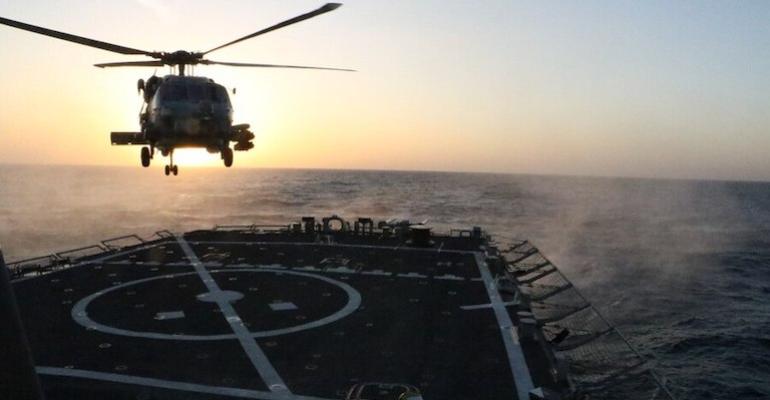Initial attacks on Israeli-linked vessels have now seen vessels from non-Israeli carriers also targeted as Dynamar consultant Darron Wadey points out: “in the past couple of weeks we have seen an audacious hijacking of a car carrier, an attempted hijacking of a product tanker, a drone strike on the 15,300 teu CMA CGM Symi and the successful interception by US Navy vessels of multiple drone and missile attacks against both commercial shipping and US naval assets.”
Avoiding the regional conflict requires lengthy journeys around the Cape of Good Hope, which could absorb some of the capacity that has been, or is due to be delivered, Wadey said, but the extra costs and time make the trip prohibitive, while overland trade cannot carry anything close to the level of volumes necessary to meet demand.
“There are no real all-water alternatives to the Cape of Good Hope, despite its substantial distance, time and financial cost implications,” Wadey explained.
Security firm Dryad Global’s CEO Corey Ranslem agrees that transport costs will rise as a result of several factors. “Firstly, the escalation in insurance premiums will contribute to higher costs. Additionally, the increase in perceived risk may lead to a significant number of vessels opting to bypass the region altogether, preferring longer routes such as circumnavigating the Horn of Africa.”
Inflation rates in western, consumer, economies are already perceived as too high and the concern is that the targeting of shipping in the conflict zone could push price levels higher, snuffing out any hint of economic recovery.
Ranslem said that it is difficult to be precise about how much the extra insurance costs will be. He said that will “largely depend on decisions made by underwriters and any changes in the Joint War Committee (JWC) policies.”
Responsibily rests with governments
The responsibility for keeping commercial shipping afloat, however, rests with governments, according to Bob McNally, the founder of Rapidan Energy.
McNally told Seatrade Maritime News: “The hard geographic and infrastructure reality is that there are only limited options for shipping companies to avoid strategically vital Middle East choke points and routes, especially the Strait of Hormuz, Bab al-Mandeb, and Suez Canal.”
As such, McNally, a former adviser to George W Bush, argues: “Governments must either successfully deter adversaries who threaten these hotspots or, if necessary, neutralise these threats militarily. One way or another, it's the responsibility of major powers invested in secure global trade to ensure the safety of key maritime trade routes.”
Initial attacks on vessels in the Red Sea, the entrance of which is a narrow strait known as the Bab al-Mandeb, which leads directly to the Suez Canal, did not have a significant effect on commercial shipping, its procedures and insurance costs, according to Munro Anderson, Head of Operations at specialist war risk underwriter Vessel Protect – part of Pen Underwriting. Although, vessels connected to Israel started operating off automatic identification systems (AIS) to evade direct targeting.
That risk was, “Perceived as localised against Israeli-connected ships, with minimal impact on broader commercial traffic, as reflected in the 'priced in' existing insurance rates,” added Anderson.
“Although, recent attacks, notably by Houthi rebels employing various kinetic means, signal a shift. These attacks are increasingly targeting vessels with less direct connections to Israel, as seen in the AOM Sophie II incident, which lacked a clear Israeli link. This trend echoes the 2021/2022 Israel/Iran ‘Shadow War’, where Iran targeted vessels like the M/V Tyndall, which had severed its Israeli connections.”
Insurance cost increase uncertain
Putting a cost on the effect of these attacks against non-Israeli commercial shipping remains a difficult calculation, argues Ranslem.
“The exact impact of insurance cost increases remains uncertain and will largely depend on decisions made by underwriters and any changes in the Joint War Committee (JWC) policies. While the JWC typically adjusts its policies at a gradual pace, there have been instances in the recent past where they have acted swiftly, such as the rapid implementation of a JWC-designated area around Israel following the outbreak of conflict there,” he said.
Nevertheless, Anderson believes that the Houthi’s tactical shift does indicate an “escalating risk” for the wider commercial market.
“While Israeli-owned vessels will continue to be high risk, all ship-owners/charterers will likely face increased premiums going forward as a result of the potential for aggregated losses to the market.”
A sense of perspective
While Anderson argues that costs are likely to rise, he also cautions the industry to maintain a sense of perspective.
“While the risk to maritime traffic has escalated, it's crucial to contextualise these events. The region sees about 33,000 transits annually and, despite heightened threats, the incidence rate remains relatively low compared to the volume of traffic,” claimed Anderson.
Meanwhile, Wadey argues there are already a number of military assets present in the region, including the EU’s NavFor Operation, originally established to protect World Food Programme cargoes for Somalia. In addition, the 38-nation Combined Maritime Task Force “already has specific responsibility for the Red Sea and Gulf of Aden”.
For Wadey the military means already exist to provide some protection to commercial shipping, which have already been successful in preventing drone and missile attacks from succeeding.
“it is not beyond the realms of possibility to see the introduction of escorted convoys of commercial ships. Indeed, there are initial soundings being made from out of the White House to that end,” he added.
Anderson, a former security consultant with Dryad Global, believes that the level of maritime protection will depend on the resolve of western governments.
He said: “The decision to enhance military protection hinges on the willingness of the international community and key regional states. It’s noteworthy that military escorts are already a standard practice in the Persian Gulf and the Maritime Security Transit Corridor (MSTC) in the Gulf of Aden and lower Red Sea.”
Copyright © 2024. All rights reserved. Seatrade, a trading name of Informa Markets (UK) Limited.
Add Seatrade Maritime News to your Google News feed.  |

